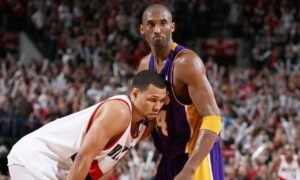Power Book IV: Force and Its Reflection on Modern Sports Dynamics
Explore how “Power Book IV: Force” reflects modern sports dynamics in our insightful blog post.
In today’s rapidly evolving world of sports, the intersection of entertainment and athletic performance is becoming increasingly complex. ‘Power Book IV: Force’ not only entertains but also mirrors the dynamics seen in modern sports. This blog will explore how the themes of ambition, rivalry, and strategy depicted in the show reflect the current landscape of sports. Let’s dive into the various aspects that connect this gripping narrative to the world of athletics.
The Ambition Behind Success in Sports
Ambition is a driving force in both ‘Power Book IV: Force’ and the sports world. Athletes and characters alike display a relentless pursuit of their goals, highlighting the common thread of striving for success. This section will delve into how the characters’ ambitions mirror those of real-life athletes.
Consider the character of Tommy Egan as a prime example; his unyielding ambition pushes him into situations that test not only his grit but also his strategic prowess. Similarly, athletes like Serena Williams embody that same intense drive as they break boundaries and redefine excellence. It’s this ambition that fuels superstar performances and keeps fans on the edge of their seats. Just as Tommy faces challenges that threaten his rise, athletes face injuries and setbacks, yet they push forward, igniting inspiration within their communities.
Furthermore, in sports, ambition often translates into preparation and mental fortitude. Just as Tommy studies his adversaries, athletes often analyze their competitors’ tactics, preparing themselves to counter any moves from opposing players. This duality of ambition—internal and external—paints a compelling picture of what it truly takes to rise to the top. In exploring both realms, we find that the thirst for success is indeed universal. It blends ambition with determination, creating a unique drive that is not only admirable but also relatable.
Rivalries that Shape Performance
Rivalries play a significant role in both the series and in sports. The fierce competition among characters in ‘Power Book IV: Force’ reflects the intense rivalries that can motivate athletes to perform at their best. In this section, we’ll explore notable rivalries in sports and how they drive success.
Take a moment to consider the fierce rivalry between characters like Tommy and his adversaries. Every encounter is charged not just with tension, but with history—their pasts intertwined, fueling their motivations. In sports, we see similar dynamics manifest in rivalries such as that between Roger Federer and Rafael Nadal. Each match becomes more than just a game; it’s a battle between legacies. These rivalries serve not only to motivate the competitors but also to galvanize fans, generating intense excitement and drawing larger audiences to the events.
Moreover, rivalries create a narrative that captivates fans and keeps them emotionally invested. Whether it’s the back-and-forth banter between characters or athletes, the storyline escalates, revealing deeper facets of their personalities and pushing them to new heights. The pressure of a rivalry can sharpen an athlete’s focus, revealing unparalleled performance levels—much like how conflict in ‘Power Book IV: Force’ reveals the depths of the characters involved. It’s this push and pull, this dichotomy of conflict and resolve, that elevates both the storyline and the sports drama. Understanding how these rivalries evolve offers insights not only into personal motivations but also the larger context of competitive spirit and its repercussions.
The Strategic Mindset of Success
Each character in ‘Power Book IV: Force’ exemplifies strategic thinking akin to that of successful athletes and coaches. This section will analyze how strategic decisions impact outcomes, both in the show and in actual sports arenas.
In the world of sports, successful athletes often rely on strategy as much as physical prowess. Just like Tommy plans his next move, athletes meticulously craft game plans, analyzing their opponents’ strengths and weaknesses to exploit vulnerabilities. This is crucial in high-stakes moments, where the difference between winning and losing can hinge on a single strategic decision. Consider the approach of a coach during pivotal moments—timeouts are called not just for rest but to reassess strategy. This same parallel exists in ‘Power Book IV: Force,’ where characters frequently navigate complex terrains that require them to think several steps ahead, leading to unexpected turns and victories.
Additionally, the mental game plays a critical role in both arenas. Athletes must maintain composure under pressure, much like Tommy does when faced with unforeseen setbacks. By dissecting the psychological components involved, we can better appreciate the intricate layers that accompany both sports and drama. Each decision, whether on the field or in the storyline, carries weight and consequence, proving that the art of strategy is not merely a concept—it is an essential element of success.
The Role of Team Dynamics
Team dynamics are essential in both the world of ‘Power Book IV: Force’ and in sports teams. Analyzing how characters interact and support one another provides insight into the importance of teamwork in achieving goals. This section discusses how strong team support can lead to victory.
In ‘Power Book IV: Force,’ the interactions among Tommy and his allies demonstrate the critical role of trust and collaboration. Just like a sports team, where every player has a unique role to contribute to the collective goal, characters often rely on one another to navigate their challenges. The development of bonds and collaboration in sports, whether on the basketball court or in football, mirrors the character arcs within the show and showcases the essence of teamwork. When players believe in one another, their performances soar, evident in both arenas.
Moreover, consider how pivotal moments often hinge on teamwork. Just as athletes must communicate and strategize in real-time during a game, characters in ‘Power Book IV: Force’ face moments where their decisions impact the group’s direction. The tension and synergy in team dynamics can create breathtaking moments, whether in the form of a last-minute game-winning shot or a dramatic twist in a storyline. As we examine these themes further, it’s clear that teamwork is a universal necessity, transcending both the screen and the field. Each character, like every athlete, has a part to play, reminding us that success is rarely achieved in isolation.
Cultural Reflections in Sports and Media
Lastly, we’ll explore how ‘Power Book IV: Force’ and modern sports share cultural reflections, addressing themes like identity and community impact. This connection deepens our understanding of both the narrative and the broader implications in sports today.
The world of sports has always been more than just games; it serves as a mirror reflecting societal values, struggles, and triumphs. Similarly, ‘Power Book IV: Force’ explores themes of identity that resonate with audiences beyond mere entertainment. Through its narrative, we see how characters navigate their place in the world, akin to how athletes often confront identity, heritage, and the weight of expectations in their careers. The cultural narratives that unfold in both contexts signal shifts in social or political climates, revealing much about the human experience.
Furthermore, the impact of community cannot be overstated. Just as a sports team can represent a city or a group, the relationships crafted in ‘Power Book IV: Force’ often symbolize deeper connections to the community. As audiences tune in, they relate—not only to the characters’ aspirations but also to their struggles as reflections of collective experiences. This narrative offers a rich lens through which one can appreciate how identity in media often parallels the ongoing conversations in sports, creating a dialogue that resonates on multiple levels. As we peel back the layers, the intertwining of sports and narrative art elucidates how closely tied our communal narratives can be, revealing our shared values and aspirations.
Final Thoughts
In conclusion, ‘Power Book IV: Force’ encapsulates the essence of modern sports dynamics. The ambition and rivalry showcased in the series serve as a powerful metaphor for the challenges athletes face in today’s competitive environment. As we recognize these parallels, it becomes clear that entertainment and sports are not as disparate as they may seem—each reflects the human experience of striving for greatness amidst myriad challenges.









